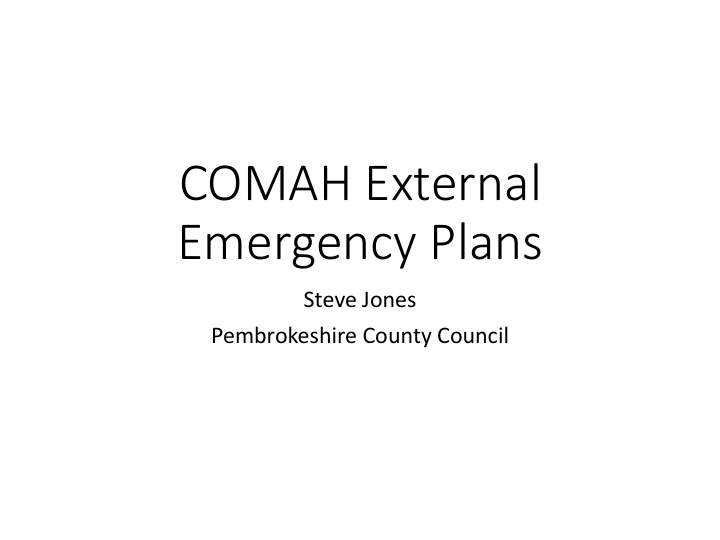



COMAH External Emergency Plans Steve Jones Pembrokeshire County Council
COMAH Regulations 1999 • Duty for Local Authorities to prepare emergency plan for accidents which result in consequences beyond the site boundary • Regulations updated in 2015 – Offsite is now External • Although sites were consulted, plans tended to be ‘imposed’. • Very little tie-in between site emergency plan and offsite plan.
COMAH Exercises • Duty to carry out live exercise every three years • Usually FRS turning up to spray lots of water / foam around • Valuable for the FRS and on site fire staff • Rarely testing specific elements of plans • No coordination between onsite and offsite responses • For some sites very difficult to come up with credible scenarios to have realistic off-site impacts
Chevron Pembroke Refinery 2 nd June 2011 • Four fatalities but not a COMAH incident • Impacts for the site and the community were no less than for a ‘full’ COMAH event • The COMAH plan was used for the response • Investigation still ongoing • Coordination was lacking in the response • Debrief identified lack of training available for tactical staff as an issue
JESIP • Since 2012 Emergency Services have been rolling out JESIP • 2016 extended to all responding agencies • The model by which responses are judged • COMAH plans now based upon JESIP Principles • COMAH exercises used as an opportunity to put into practice JESIP theory
JESIP / COMAH Exercises • Problem identified that only FRS & HART go inside Security fence • An argument over which vehicle bonnet was OCG • Solution to pre-identify rooms / facilities as multi-agency OCG • These have been agreed and placed in COMAH Plans • Also since tested in COMAH exercises ( worked well )
South Hook LNG Planning • The site were busy refreshing their onsite plans and training staff for specific roles • They suggested that the on and off-site plans should align • Asked us to use the same Representative Scenarios from their HSE Safety Report. • Even asked that we use their computer graphics to ensure both sets of plans seamlessly align.
South Hook LNG Exercise Puffin 2015 • The first live test of the merged plans / responses • Multi-agency OCG (Bronze) sited next room to Onsite Incident Management Team • Information flows were good, particularly ensuring casualty figures, names & destinations were correct • A certain lack of understanding of roles between site staff and responders was evident Multi-agency OCG SHLNG Incident Management Team
Post Exercise • It’s no good having an exercise without identifying good practice and areas for improvement • Following a COMAH exercise a debrief report is prepared into the multi-agency response • This is shared with the other Industrial Partners via the LRF Industrial Hazards Group • Recommendations are tracked on the LRF Performance Management System to ensure they are not forgotten
The Way Forward • In 2017 the LRF TCG Training was adapted to allow for partners from industrial facilities to participate • The sites have put aside commercial confidentiality to allow observers in each other’s exercises • Efforts are underway to align on-site response mechanisms and roles between the sites • A programme of annual multi-agency COMAH 360 o visits: A site visit for tactical commanders to experience the topography and site processes A briefing from SHLNG regarding their emergency response and expectations of Responding agencies Counter briefings from Emergency Responders about their roles and expectancies from the site Particularly relevant is the briefing of what to expect in the event of deaths on site
Progress so far • What used to be a very much ‘Us’ and ‘Them’ approach to planning, training and exercising is no longer the case • Now it is just ‘ Us ’ • A recognition that a problem for one can affect us all • Hopefully the next time there is a major incident the multi agency response will be better coordinated. Downside As the level of training and expertise of site staff increases, they start to recognise some of the shortcomings of other responding agencies who tend to have a higher rate of staff turnover
Thank you Any Questions?
Recommend
More recommend